फल फसलों के सिलाईड (Psyllid) कीट और उनके प्रबंधन
Psyllids pests are major problem in fruit crops under Indian subcontinent. Psyllids pests feeds phloem sap form plants, belongs to series Sternorryncha of suborder Homoptera. The group comprises over 3000 species of psyllids in 235 recognised genera, distributed worldwide.
Super family Psylloidea comprises 6 families viz., Psyllidae, Calophyidae, Phacopteronidae, Homotomidae, Carsidaridae and Triozide. Psyllids are free living and 15 per cent of known species of psyllids are gall inducers. Life cycle of psyllids involves an egg stage, five nymphal instars before becoming adult.
Basic characters of Psyllid pests
- Adult psyllids resemble miniature cicads, ranging in length from 1-10 mm
- Both sexes posses two pairs of wings, forewings with harder constitency than hind wings
- Beak is short and three segmented
- Five nymphal instars, wingless, possessing fore wing and hind wing pads.
- Nymphs produce white waxy secretions
- Psyllids are dioecious and at emergence the sexes normally occur in a ratio of 1:1.
- Male and female produces sex specific and species specific acoustic signals during mating
- Economically important as pest, vector and biocontrol agent
Biology of Psyllids
Eggs of Psyllids
The eggs are generally brown to black in colour, 1 mm long and ovoid in shape, although colour, size, and shape can vary slightly between species.
Each female lays between 45 and 700 eggs, either in clusters of approximately 10-150 eggs or in rows on leaf surfaces.
Eggs are usually equipped with a stalk, which upon insertion, anchors the eggs to the leaf surface. Following a 10-20 day incubation period, the egg shells split along their length, thereby allowing instar I nymphs to emerge.
Nymph of Psyllids
The newly hatched nymphs (or ‘crawlers’) move over the leaf surface in search of a stomata for insertion of their stylets and feed on plant sap, usually within 48 hours of hatching.
Once settled, they commence construction of a shell (more commonly known as a ‘lerp’) from starchy material derived from the host plant.
It is commonly thought that the lerp structure protects the psyllid insect from predation and desiccation during warm/hot weather. Nymphs usually pass through five instars (or ‘moults’) before becoming adults.
Adult
Adult psyllids are generally small (<5 mm length), yellow coloured with black markings and equipped with two pairs of wings. They are strong fliers and jumpers.
Eggs Pupa Adult
Biology of Psyllids
Economically important Psyllids
Psyllidae comprises pestiferous species like Asian citrus psyllid, Diaphorina citri (Kuwayama); African citrus psyllid, Trioza erytrae (Del Guercio); Mango shoot gall psyllid, Apsylla cistellata (Buckton); Common pear psyllid, Cacopsylla pyricola (Foerster); Apple psyllid, Cacopsylla mali (Schmidberger); Subabul psyllid, Heteropsylla cubana (Crawford); Fig psyllid, Mycopsylla fici (Tryon) and Potato psyllid, Bactericera cockerelli (Sulc.).
They cause damage not only by direct feeding but also as vectors of deadly diseases like citrus greening, pear decline and apple proliferation.
Apart from pests, a few species of psyllids, Arytinnis hakani (Loginova), Boreioglycaspis melaleucae (Moore), Prosopidopsylla flava (Burckhardt) and Arytainillaspartiophila (Foerster) are exploited as biocontrol agents of weeds in some countries like Australia.
Psyllid pests of fruit crops
1. Asian Citrus Psylla, Diaphorina citri Kuwayama
It is a major pest of citrus and attacks new flush of all the seasons (Dorge et al., 1968). It is also known to inject certain toxin while feeding on the flushes which causes die back.
Psyllid feeding also results in reduction of shoot length giving a witches' broom effect. If heavy feeding occurs early on the developing flush, the new flush will fail to develop or abort. In addition to direct feeding damage to plants, it is also an efficient vector of the bacterium, Candidatus Liberibacter asiaticuswhich causes greeningdisease of citrus leading to slow death (Pluke et al., 2008).
Disease symptoms include mottling, chlorosis resembling zinc deficiency, twig dieback and reduced fruit size and quality. Fruit do not color properly, leading to the name citrus greening.
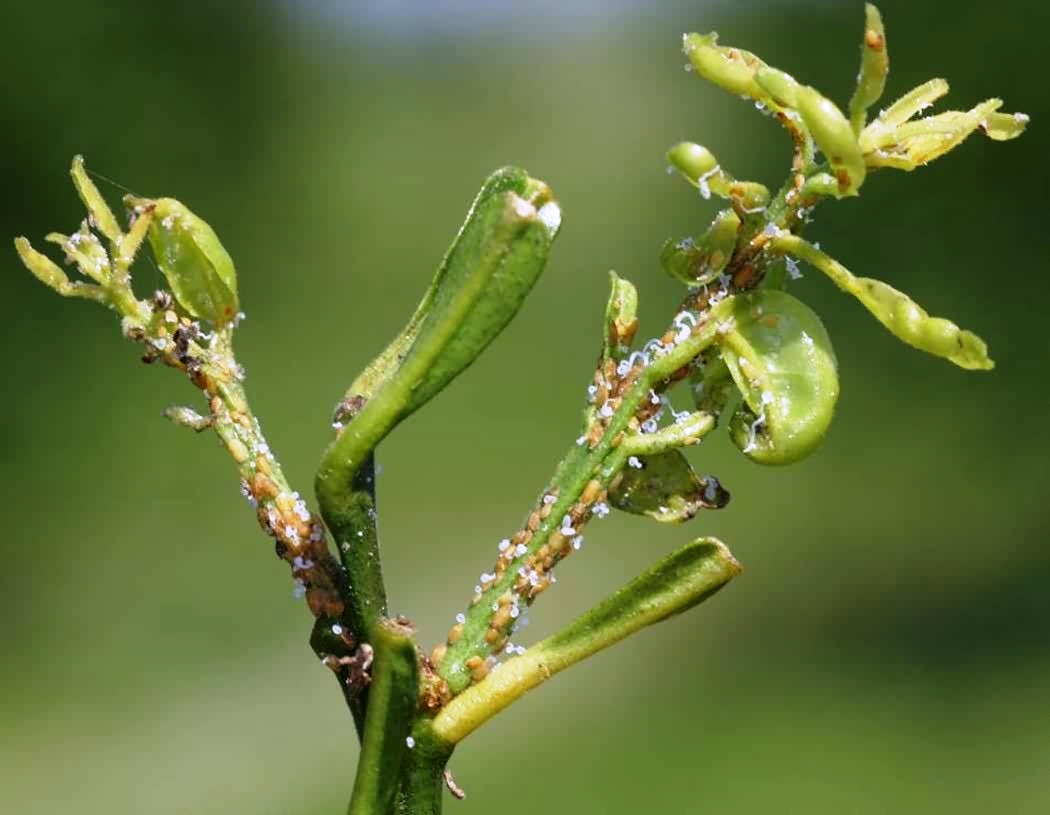 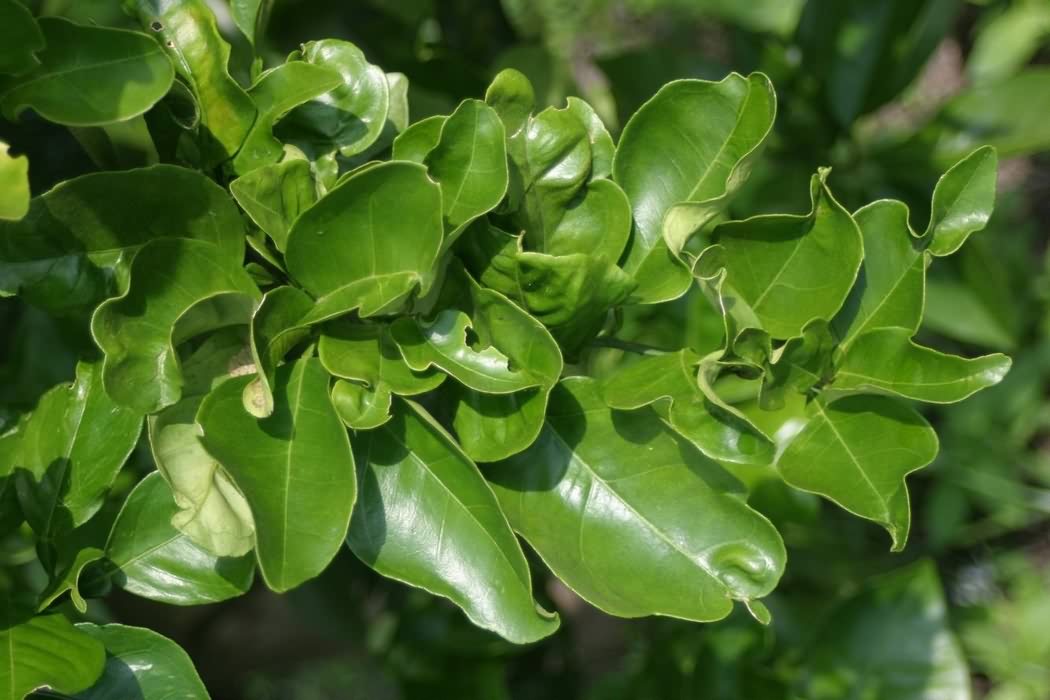  |
||
|
Damage to new leaves by psyllid nymphs |
Witches' broom effect caused by psyllid feeding | Dieback of new growth from feeding by psyllid nymphs |
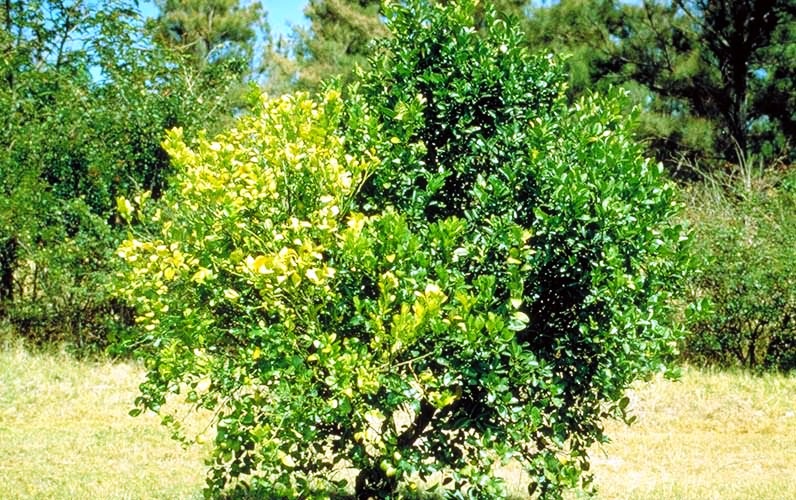 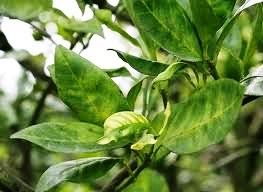 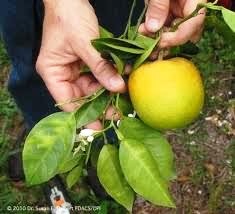 |
||
| Symptoms due to citrus greening disease | ||
2. Mango shoot gall psylla, Apsylla cistellata (Buckton)
 It is a serious pest of mango in northern India. Adults are brownish black in colour with membranous wings (Mathur, 1975).
It is a serious pest of mango in northern India. Adults are brownish black in colour with membranous wings (Mathur, 1975).
It is reported from Uttar Pradesh, Bihar and Terrai regions of northern India. It causes the formation of shoot galls in place of buds.
Galls are modified axillary and apical buds. Feeding effect of neonate nymphs which remain in egg case induces the modification of buds to galls. Second instar nymph migrates to the already formed gall.
Loss depends on the number of eggs laid; 500 eggs in all leaves result in induction of 52 galls and reduce panicle emergence by 21 per cent. Heavily infested tree yields only 5 kg fruit against a normal yield of 300 kg.
Infested shoots have high auxin level and low phenolic content (Kumar et al., 2007).
3. Common Pear Psyllid, Cacopsylla pyricola (Foerster)
Pear psylla, a western Europe native, is a very small sap-feeding insect and is considered the most serious insect pest of pear in the United States. Serious infestations can stunt, defoliate, and even kill trees.
Psylla feeding produces copious amounts of sticky honeydew that can cause fruit russetting. All commercial pear varieties are attacked, although smooth skinned pears are more injured than russeted varieties, and Asian and red pears are less prone to injury than European and green pears.
Management of Psyllid pests of fruit crops
Direct control involves the use of pesticides or physical control measures, while biological control concerns the actions of indigenous predators such as birds, various insects, spiders, mites and fungi in limiting pest populations.
Cultural control relates to the tending and caring of trees to encourage healthy growth, thus enabling them to be better able to withstand and recover from damaging attacks.
Genetic control involves the selection of genetically resistant genotypes for use in plantings as well as the genetic manipulation of biological control agents to increase their efficacy against the target pest.
Cultural control
- Balanced fertilization and irrigation in the dry season to avoid the concentration of nutrients in leaves
- Application of silicon for formation of defense structures such as trichomes, spines and leaf toughness by forming polymers (crystals) that are immobilized in the leaf tissue (Camargo et al., 2011).
- The application of industrial ashes rich in silicates has been recommended.
- Avoid summer pruning which encourages shoot growth
- Infected twigs and trees should be removed as disease symptoms appear.
- Pulling out water suckers from scaffold twigs.
Plant resistance
- Prevention of planting susceptible species is the best way to avoid damage
- Tolerant varieties for mango shoot gall psylla : Makaram, Chinnaswarnarekha, Mulgoa, Delhi, K.O-11.
- Sweet oranges, mandarins and tangelos are most susceptible, grapefruit and lemon are more resistant, and limes, Poncirus trifoliata and citranges are the most tolerant for citrus greening disease.
Biological control
Asian citrus psyllid
- Parasitoids : Eulophid parasite, Tamarixia (Tetrasticus) radiata (Waterston), encyrtid endoparasite, Diaphorencyrtus aligarhensis
- Fungal pathogens: Cladosporium sp. nr. oxysporum and Capnodium citri Hirsutella citriformis Speare
- Predators: Mallada boninensis (Okamoto) and Cheilomenes sexmaculata (Fabricius); histerid beetle, Saprinus chalcites (Illiger) ;predaceous carabid, Egapola crenulata.
- Biological control of the citrus greening pathogen using several strains of CTV through cross protection (Van Vuuren et al., 2000)
Pear psylla (Cacopsylla pyricola)
- Parasitoid wasps : Endoparasites, Trechnites psyllae and Prionomitus mitratus
- Predators: Anthocorid bugs, predaceous plant bugs, Lacewing adults and larvae, Ladybird beetle adults and larvae, Spiders.
- Effectiveness of biological control increases in orchards where fewer codling moth treatments are applied.
Chemical control
Monitoring of the psyllids is done by installing sticky traps or by manual sampling. Timing of pesticide is critically based on monitoring of psyllids. For phloem-sucking Sternorrhyncha, systemic pesticides are effective, trunk applications have proven useful. The best time to apply is just prior to spring flush.
Asian Citrus Psyllid
- Populations are considered high when population reaches three nymphs and five adults per twig.
- Chemical control using dimethoate 30 EC @ 1.25 ml or imidacloprid 17.8 SL @ 0.3 ml or quinalphos 25 EC @ 1.0 ml or acephate 75 SP @ 1g at bud burst stage. Second spray should follow after 10-15 days (Shivankar and Rao, 2010).
- Extracts of botanicals like Vitex nigundo, Acorus calamus can also be used
Mango shoot gall Psylla
- Spraying of dimethoate 30 EC (0.03%) during 2nd fortnight of July followed by two more sprays at 10 days interval.
- Bark pasting using dimethoate.
- Bark injection using dimethoate 30 EC @ 0.3 ml a.i./cm circumference.
- Spraying 2, 4-D @ 150 mg/l for autocidal control of nymphs (Singh, 2005; Kumar et al., 2007).
Pear psylla (Cacopsylla pyricola)
- Pre-bloom: Lambda-cyhalothrin, Lime sulfur, Permethrin, Pyriproxyfen, Esfenvalerate.
- Post bloom : Carbaryl, Clothianidin, Thiacloprid, Imidacloprid
Conclusion
Development of pest forecasting system by combining the available data on biology of psyllid pests and weather parameters and development of bio-intensive integrated pest management modules is a viable method for management of psyllids.
References
- Camargo J M M, Moraes J C, Zanol K R M and Queiroz D L (2011) Interação silício einsetos-praga: Defesa mecânica ou química? Revista de Agricultura (Piracicaba)85, 10-12.
- Dorge S K, Borle M N, Sonawane B R and Naik L M (1968) Pests of fruits crops and their control in Maharashtra. Tech. Bull. 15, Govt. of Maharashtra, India, pp. 66.
- Kumar A, Verma T D and Gupta D (2007) Biological studies on mango shoot gall psylla, Apsylla cistellata Buckton in Himachal Pradesh. Pest Management inHort. Ecosystems 13(1), 13-19.
- Mathur R N (1975) Psyllidae of the Indian Subcontinent. Indian Council of Agricultural Research, New Delhi. p. 429.
- Pluke R W H, Quershi J A and Stansly P A (2008) Citrus flushing patterns, Diaphorinacitri (Hemiptera: Psyllidae) populations and parasitism by Tamarixia radiate (Hymenoptera: Eulophidae) in Peurto Rico. Florida Entomologist 91(1), 36-42.
- Shivankar V J and Rao C N (2010) Psyllids and their management. Pest Management in Hort. Ecosystems16(1), 1-4.
- Van Vuuren S P, Van Der Vyver J B, Luttig M and Da Graca J V (2000) Low incidence of hunaglongbing fruit symptoms in the presence of a population of citrus tristeza virus, In: Proc. 14th Conference of the International Organization of Citrus Virologists, (Eds. Da Graca J V, Lee R F and Yokomi R K),Riverside, CA. pp. 373-377.
Authors:
Sagar, D., Suresh M. Nebapure, P.S. Soumia, G. Guru Pirasanna Pandi* and Shashank, P. R.
Division of Entomology, Indian Agricultural Research Institute, New Delhi-110 012
*e-mail of corresponding author:




